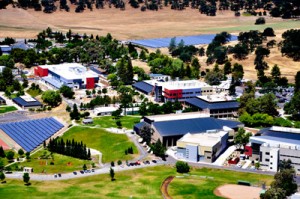 CYPRESS, Calif. Using solar energy, Butte College in Oroville, Calif., plans to be one of the first colleges in the U.S. to produce more energy than it consumes. While the college has been using solar energy for three years, the board of trustees approved its Phase III solar project which is expected to be completed by May 2011. Butte College will install more than 14,000 Mitsubishi Electric solar modules capable of producing 3,481,920 kWh of clean energy per year. This 2.7 MW DC installation is an addition to the 10,000 solar panels the college already has, making the total system size 4.55 MW DC.
CYPRESS, Calif. Using solar energy, Butte College in Oroville, Calif., plans to be one of the first colleges in the U.S. to produce more energy than it consumes. While the college has been using solar energy for three years, the board of trustees approved its Phase III solar project which is expected to be completed by May 2011. Butte College will install more than 14,000 Mitsubishi Electric solar modules capable of producing 3,481,920 kWh of clean energy per year. This 2.7 MW DC installation is an addition to the 10,000 solar panels the college already has, making the total system size 4.55 MW DC.
“We congratulate Butte College for setting an example for its students, its community and other colleges in the nation by choosing solar energy as its energy source”
“Once this solar project is completed, Butte College will provide enough clean renewable energy to cover all of our electricity needs and generate slightly more than we use—which will be a source of additional revenue for the college,” said Diana Van Der Ploeg, president of Butte College.
The solar panels will be installed by a joint venture between Chico Electric and DPR Energy which designs and installs commercial and residential solar systems in California.“We have worked with Butte College for years and are proud to facilitate this cutting-edge project for such a forward-thinking institution,” says Norm Nielsen, president of Chico Electric. The modules will be installed on the ground and on rooftops that will create covered parking areas and walkways. Mitsubishi Electric modules were used for a previous installation at the college and were chosen again due to their high-reliability and use of 100% lead-free solder. “We congratulate Butte College for setting an example for its students, its community and other colleges in the nation by choosing solar energy as its energy source,” says Gina Heng, general manager of Mitsubishi Electric & Electronics USA’s Photovoltaic Division.
The total funding for the project is $17 million with $12.65 million of this amount funded by federal Clean Renewable Energy Bonds (CREBs). The remainder, up to $4.35 million, will be funded by the college from its annual budget allocated to purchasing electricity from the grid. The college will receive almost $1 million in rebates from Pacific Gas & Electric, the California Solar Initiative and benefits from the American Recovery and Reinvestment Act/CREBs allocations. The CREBs for the project were arranged and funded by Bank of America as part of its 10-year, $20 billion business initiative to address climate change.
Butte College Wins Global Warming Solution Award
UPDATE: A NEW GREEN RENAISSANCE II
 Listen Here or Listen Here
Listen Here or Listen Here
 Learn about: Solar Bill of Rights
Learn about: Solar Bill of Rights
10 Great Green Opportunities
By Brita Belli, Kathryn Gutlebar, Julia Hirsch, Jesica Knoblauch, Shawn Query
 Everything’s coming up green. Across every industry, new job possibilities are emerging for those with the skills to bridge the divide between the old, fossil-fuel-based economy and the new, energy-efficient one. Corporations once demonized for their role in creating pollution and exploiting workers are being held accountable; they are partnering with nonprofits and hiring corporate social responsibility managers. They are finding that reducing their impact is as good for future profits as for the planet at large. There’s no secret to getting a job in the new green economy. It’s as basic as applying the job skills you’ve already developed (web design, sales, management) to a nonprofit or sustainable industry, or coordinating sustainable practices from within a corporate entity. Sometimes, as in green building or solar panel installing, these green jobs require a specific set of skills—and classes are organizing to fill the growing need. Other times, as in the organic food industry, ecotourism or sales and marketing of energy-efficient technology, anyone with a good work ethic can get in and create a great green career. Read on here
Everything’s coming up green. Across every industry, new job possibilities are emerging for those with the skills to bridge the divide between the old, fossil-fuel-based economy and the new, energy-efficient one. Corporations once demonized for their role in creating pollution and exploiting workers are being held accountable; they are partnering with nonprofits and hiring corporate social responsibility managers. They are finding that reducing their impact is as good for future profits as for the planet at large. There’s no secret to getting a job in the new green economy. It’s as basic as applying the job skills you’ve already developed (web design, sales, management) to a nonprofit or sustainable industry, or coordinating sustainable practices from within a corporate entity. Sometimes, as in green building or solar panel installing, these green jobs require a specific set of skills—and classes are organizing to fill the growing need. Other times, as in the organic food industry, ecotourism or sales and marketing of energy-efficient technology, anyone with a good work ethic can get in and create a great green career. Read on here
